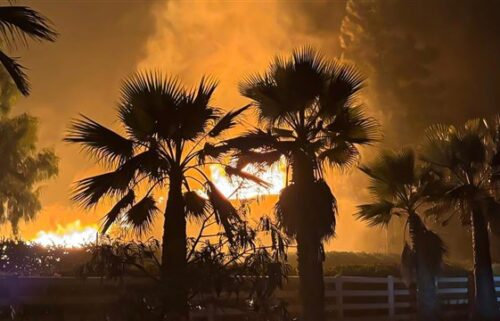Study says California’s 2023 snowy rescue from megadrought was a freak event. Don’t get used to it
By BRITTANY PETERSON and SETH BORENSTEIN
Associated Press
DENVER (AP) — Last year’s snow deluge in California, which quickly erased a two decade long megadrought, was essentially a once-in-a-lifetime rescue from above, a new study found.
Don’t get used to it because with climate change the 2023 California snow bonanza —a record for snow on the ground on April 1 — will be less likely in the future, said the study in Monday’s journal Proceedings of the National Academy of Sciences.
The study authors coined the term “snow deluge” for one-in-20-year heavy snowfalls, when it’s cold and wet enough to maintain a deep snowpack through April 1. But even among these rare snow deluges, last year’s stood out as the snowiest, edging out 1922 in snow water equivalent, said study lead author Adrienne Marshall, a hydrologist at the Colorado School of Mines.
It’s timing couldn’t be better. Last year’s snow came after a megadrought that started around the turn of the century and was one of the worst in more than 1,000 years. That drought is gone now.
“We shouldn’t count on these big snow years coming every couple of years to bail us out,” Marshall said.
Looking at different scenarios of emissions of heat-trapping gases in the future, she said it would be “increasingly rare” for most people alive now to see snow like this in California in the future. Her team’s calculations show that these 1-in-20 year deluges will be 58% smaller by the end of this century compared to recent decades, with even just moderate climate change.
UCLA climate scientist Daniel Swain, who wasn’t part of the study but specializes in weather in the U.S. West, said, “I would not be surprised if 2023 was the coldest, snowiest winter for the rest of my own lifetime in California.”
And given climate change it’s even more of a sure thing that winter was likely the coldest that most Californians will experience in the rest of their lives, Swain said.
The snow deluges came from repeated atmospheric rives, said Mark Serreze, director of the National Snow and Ice Data Center, who was not part of the research.
“California is no stranger to atmospheric rivers, but having so many was pretty bizarre,” Serreze said. “Maybe we are moving back to a wetter regime, but even if we are, there is simply not enough water go around anymore. And as the climate warms, the snowpack will keep shrinking, making it harder and harder to manage the water resources.”
California snowpack meets on average just 30% of the state’s water needs – the rest is mostly imported or pumped from the ground. This year’s April 1 snowpack was the second consecutive year of above average accumulation.
Residents and especially officials negotiating water rights, a contentious issue in the West, have to keep snow droughts in their memory even if California is flush from last year’s “gift” of a snow deluge, Marshall said.
Her team focused on snow rather than all types of precipitation. That’s because a rainy winter doesn’t help bank as much water for California’s hot dry summers.
“Dams and reservoirs have kind of long been environmentally contentious in California and elsewhere, and we have this massive natural reservoir in the mountains, and that’s snowpack,” Marshall said. “So when water falls as snow, it sits around in the mountains for often quite a long time and then melts in the late spring and the summer when we need it the most.”
The study also found that as the climate warms, there still will be years with snow deluges but they will be far lighter than now if greenhouse gas emissions aren’t rapidly reduced.
Although the study looked at just California, Marshall said her team saw similar projected patterns for across the West.
“Despite the inconveniences and even dangers of excessive snowfall in the Sierras, all should remain grateful that water ‘rescues’ have taken place as recently as 2023,” said Rutgers University Global Snow Lab Director David Robinson, who wasn’t part of the study.
But Robinson said these exceptionally wet, cold years will occur even less in the future so it’s a reminder “how precious and finite our freshwater resources are now and will remain so in our ongoing warming world.”
Read more of AP’s climate coverage at http://www.apnews.com/climate-and-environment
___
Follow Brittany Peterson and Seth Borenstein on X at @BrittanyKPeters and @borenbears
______
The Associated Press receives support from the Walton Family Foundation for coverage of water and environmental policy. The AP is solely responsible for all content. For all of AP’s environmental coverage, visit https://apnews.com/hub/climate-and-environment



